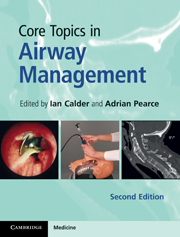
- Cited by 2
-
Cited byCrossref Citations
This Book has been cited by the following publications. This list is generated based on data provided by Crossref.
Black, Ann E. Flynn, Paul E.R. Smith, Helen L. Thomas, Mark L. Wilkinson, Kathy A. and Cote, Charles 2015. Development of a guideline for the management of the unanticipated difficult airway in pediatric practice. Pediatric Anesthesia, Vol. 25, Issue. 4, p. 346.
Rosales Lillo, Felipe Cabezas Godoy, Catalina Belén Figueroa Sobrino, Camila Fernanda Hevia Acuña, Stephanie Alexandra and Skinner Palma, Constanza Beatriz 2022. Características de los pacientes con alteraciones de la deglución hospitalizados en UPC con diagnóstico de SARS-CoV-2: una revisión sistemática. Revista de Investigación en Logopedia, Vol. 12, Issue. 1, p. e79196.
- Publisher:
- Cambridge University Press
- Online publication date:
- January 2011
- Print publication year:
- 2010
- Online ISBN:
- 9780511760310


